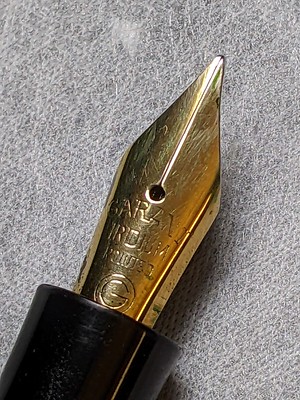At First Glance
Here's a good-looking fountain pen. The name is Garant Alkor.
Garant was a pen manufacturer in the former East Germany (DDR) in the 1950s. Some of their pens were identified as late as the 1960s. Beyond that, sadly, very few pen factories survived globally, and among those who did, there are even fewer who still manufacture fountain pens.
This "Alkor" is considered the top-of-the-line model. There are the Nilor and Silor models (and maybe others that I'm not aware of) which are smaller.
It's quite a big vintage pen, clocking at 5-3/8 inches (or 136 mm) capped. The "girth" (barrel diameter) is about 13 mm, and the cap diameter is 14.6 mm at the widest part. Far from being small and skinny.
Here it is with fellow German piston fillers from around the same era, the Montblanc 254 and the Pelikan 400:
As you can see, it is quite big compared to the Pelikan, and the Montblanc.How about the nib? Glad you asked. The nib is original, marked Garant Iridium:
It writes somewhere between Fine and Medium depending on how absorbent your paper is. The fit between the nib and the feed is excellent as typical of these old German pens, and it translates into consistent ink flow and a fun writing experience.
Like any other German pens made in that era, this is a piston filler. I, as some of you know, not only love German piston-fillers as writers (or sketchers), but I'm fascinated by these from the restoration aspect. So far, I have seen quite a few variations of piston-filling mechanism designs. Most of them are good designs and obviously built well enough to survive the decades.
This pen is no exception. It too, has an interesting piston mechanism design. Let's check it out.
Getting into the Pen
First of all, I need to get into the piston seal to see why it wasn't working. Ink just won't get into the chamber. If we're lucky, the seal just needs some silicon grease, if not then we need to replace the seal. Either way, I need to disassemble the piston mechanism.
When you open the blind cap of a German piston filler, the variety of designs may already present itself. That is, if the pen happens to have removable one, some, like for example modern Montblanc or Pelikan, don't.
On this pen, upon opening the blind cap, you see that it is threaded into the barrel. Other more commonly found designs have a part that extrude from the back of the barrel, where the blind cap screw unto and thus covering it.
This is when I point my flashlight into the opening:
What are we looking at? It looks like a metal ring that is threaded to secure the piston dial. At the 5 o'clock position, shine by the light is actually a dimple, a notch. There is another one 180 degrees from it on the other side of the plastic dial.And, I wasn't mistaken. Using my trusty tweezer, which has been used in this fashion many times before, I was able to rotate the metal ring after a few tries.
Here you can see that part of the metal ring started to show coming out of the barrel:
Unscrewing the metal ring out of the barrel, the dial is then attached to an orange cylinder that acts as a stopper. The plastic helical (actually more like "sawtooth" than a true helix) part that moves the seal up and down the barrel fits into the orange stopper one-way only.
When it comes to remembering how parts work together, I rely on a diagram which I usually do for certain restorations, which you can see at the bottom of this write up.






Comments
Post a Comment